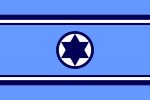
Back Israeliese Lugmag Afrikaans القوات الجوية الإسرائيلية Arabic İsrail Hərbi Hava Qüvvələri Azerbaijani Ваенна-паветраныя сілы Ізраіля Byelorussian Força Aèria Israeliana Catalan ھێزی ئاسمانیی ئیسرائیل CKB Izraelské vojenské letectvo Czech Heyl Ha'Avir Danish Israelische Luftstreitkräfte German Fuerza Aérea Israelí Spanish
| Israeli Air and Space Arm | |
|---|---|
| |
 Emblem of the Israeli Air and Space Arm | |
| Founded | 28 May 1948 |
| Country | |
| Type | |
| Role | |
| Size | |
| Part of | Israel Defense Forces |
| Headquarters | HaKirya, Tel Aviv, Israel |
| Website | www |
| Commanders | |
| Commander of the Air Force | Aluf Tomer Bar |
| Insignia | |
| Roundel |   |
| Flag |  |
| Aircraft flown | |
| Attack | Boeing F-15I Ra'am, AH-64D Saraf |
| Fighter | McDonnell Douglas F-15 Eagle, General Dynamics F-16 Fighting Falcon, Lockheed Martin F-35 Lightning II |
| Patrol | Eurocopter AS565 Panther |
| Reconnaissance | IAI Eitam, Beechcraft RC-12D |
| Trainer | Grob G-120, Beechcraft T-6 Texan II, Alenia Aermacchi M-346 Master, Beechcraft C-12 Huron, Bell 206 |
| Transport | Boeing 707-320, Lockheed C-130 Hercules, Sikorsky CH-53 Sea Stallion, Sikorsky S-70 |
| Tanker | Lockheed KC-130 Hercules, Boeing KC-707 |
The Israeli Air Force (IAF; Hebrew: זְרוֹעַ הָאֲוִיר וְהֶחָלָל, romanized: Zroa HaAvir VeHahalal, lit. 'tl', "Air and Space Arm", commonly known as חֵיל הָאֲוִיר, Kheil HaAvir, "Air Corps") operates as the aerial and space warfare branch of the Israel Defense Forces (IDF). It was founded on May 28, 1948, shortly after the Israeli Declaration of Independence. As of April 2022[update], Aluf Tomer Bar has been serving as the Air Force commander.
The Israeli Air Force was established using commandeered or donated civilian aircraft and obsolete and surplus World War II combat aircraft. Eventually, more aircraft were procured, including Boeing B-17s, Bristol Beaufighters, de Havilland Mosquitoes and P-51D Mustangs. The Israeli Air Force played an important part in Operation Kadesh, Israel's part in the 1956 Suez Crisis, dropping paratroopers at the Mitla Pass. On June 5, 1967, the first day of the Six-Day War, the Israeli Air Force performed Operation Focus, debilitating the opposing Arab air forces and attaining air supremacy for the remainder of the war.
Shortly after the end of the Six-Day War, Egypt initiated the War of Attrition, and the Israeli Air Force performed repeated bombings of strategic targets deep within enemy territory. When the Yom Kippur War broke out on October 6, 1973, Egyptian and Syrian advances forced the IAF to abandon detailed plans for the destruction of enemy air defences. Forced to operate under the missile and anti-aircraft artillery threats, the close air support it provided allowed Israeli troops on the ground to stem the tide and eventually go on the offensive.
Since that war most of Israel's military aircraft have been obtained from the United States. Among these are the A-4 Skyhawk, F-4 Phantom II, F-15 Eagle, F-16 Fighting Falcon and F-35 Lightning II. The Israeli Air Force has operated a number of domestically produced types such as the IAI Nesher, and later, the more advanced IAI Kfir. On June 7, 1981, eight IAF F-16s covered by six F-15s carried out Operation Opera to destroy the Iraqi nuclear facilities at Osiraq. On June 9, 1982, the Israeli Air Force carried out Operation Mole Cricket 19, crippling Syrian air defences in Lebanon. On October 1, 1985, In response to a PLO terrorist attack which murdered three Israeli civilians in Cyprus, the Israeli air force carried out Operation Wooden Leg, bombing the PLO Headquarters in Tunis. In 1991, the IAF carried out Operation Solomon which brought Ethiopian Jews to Israel. In 1993 and 1996, the IAF participated in Operation Accountability and Operation Grapes of Wrath, respectively. It has taken part in many operations since, including the 2006 Lebanon War, Operation Cast Lead, Operation Pillar of Cloud, Operation Protective Edge, Operation Guardian of the Walls and Operation Swords of Iron. On September 6, 2007, the Israeli Air Force successfully bombed an alleged Syrian nuclear reactor in Operation Orchard.[3]
- ^ a b International Institute for Strategic Studies (February 15, 2023). The Military Balance 2023. London: Routledge. p. 331. ISBN 9781032508955.
- ^ Hoyle, Craig (2023). "World Air Forces 2024". FlightGlobal. Retrieved March 7, 2024.
- ^ Mahnaimi, Uzi (September 16, 2007). "Israelis 'blew apart Syrian nuclear cache'". The Sunday Times. London, UK. Archived from the original on March 8, 2018. Retrieved July 13, 2008.
© MMXXIII Rich X Search. We shall prevail. All rights reserved. Rich X Search